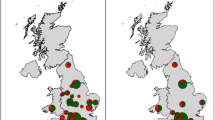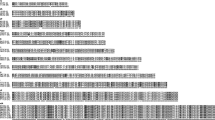Abstract
Burkholderia mallei (the etiologic agent of glanders in equines and rarely humans) and Burkholderia pseudomallei, causing melioidosis in humans and animals, are designated category B biothreat agents. The intrinsically high resistance of both agents to many antibiotics, their potential use as bioweapons, and their low infectious dose, necessitate the need for rapid and accurate detection methods. Current methods to identify these organisms may require up to 1 week, as they rely on phenotypic characteristics and an extensive set of biochemical reactions. In this study, Raman microspectroscopy, a cultivation-independent typing technique for single bacterial cells with the potential for being a rapid point-of-care analysis system, is evaluated to identify and differentiate B. mallei and B. pseudomallei within hours. Here, not only broth-cultured microbes but also bacteria isolated out of pelleted animal feedstuff were taken into account. A database of Raman spectra allowed a calculation of classification functions, which were trained to differentiate Raman spectra of not only both pathogens but also of five further Burkholderia spp. and four species of the closely related genus Pseudomonas. The developed two-stage classification system comprising two support vector machine (SVM) classifiers was then challenged by a test set of 11 samples to simulate the case of a real-world-scenario, when “unknown samples” are to be identified. In the end, all test set samples were identified correctly, even if the contained bacterial strains were not incorporated in the database before or were isolated out of animal feedstuff. Specifically, the five test samples bearing B. mallei and B. pseudomallei were correctly identified on species level with accuracies between 93.9 and 98.7 %. The sample analysis itself requires no biomass enrichment step prior to the analysis and can be performed under biosafety level 1 (BSL 1) conditions after inactivating the bacteria with formaldehyde.

ᅟ


Similar content being viewed by others
References
Galyov EE, Brett PJ, DeShazer D (2010) Molecular Insights into Burkholderia pseudomallei and Burkholderia mallei pathogenesis. Annu Rev Microbiol 64:495–517
Estes DM, Dow SW, Schweizer HP, Torres AG (2010) Present and future therapeutic strategies for melioidosis and glanders. Expert Rev Anti-Infect Ther 8(3):325–338
Coenye T, Vandamme P (2003) Diversity and significance of Burkholderia species occupying diverse ecological niches. Environ Microbiol 5(9):719–729
Fong IW, Alibek K (2009) Bioterrorism and infectious agents: a new dilemma for the 21st century. Emerging infectious diseases of the 21st century. Springer-Verlag, New York
Wheelis M (1998) First shots fired in biological warfare. Nature 395(6699):213–213
Cheng AC (2010) Melioidosis: advances in diagnosis and treatment. Curr Opin Infect Dis 23(6):554–559
Khan I, Wieler LH, Melzer F, Elschner MC, Muhammad G, Ali S, Sprague LD, Neubauer H, Saqib M (2013) Glanders in animals: a review on epidemiology, clinical presentation, diagnosis and countermeasures. Transbound Emerg Dis 60(3):204–221
Lowe W, March JK, Bunnell AJ, O’Neill KL, Robison RA (2014) PCR-based methodologies used to detect and differentiate the Burkholderia pseudomallei complex: B. pseudomallei, B. mallei, and B. thailandensis. Curr Issues Mol Biol 16(1):23–54
Hagen RM, Frickmann H, Elschner M, Melzer F, Neubauer H, Gauthier YP, Racz P, Poppert S (2011) Rapid identification of Burkholderia pseudomallei and Burkholderia mallei by fluorescence in situ hybridization (FISH) from culture and paraffin-embedded tissue samples. Int J Med Microbiol 301(7):585–590
Podin Y, Kaestli M, McMahon N, Hennessy J, Ngian HU, Wong JS, Mohana A, Wong SC, William T, Mayo M, Baird RW, Currie BJ (2013) Reliability of automated biochemical identification of Burkholderia pseudomallei is regionally dependent. J Clin Microbiol 51(9):3076–3078
Karger A, Stock R, Ziller M, Elschner MC, Bettin B, Melzer F, Maier T, Kostrzewa M, Scholz HC, Neubauer H, Tomaso H (2012) Rapid identification of Burkholderia mallei and Burkholderia pseudomallei by intact cell matrix-assisted laser desorption/ionisation mass spectrometric typing. BMC Microbiol 12
Li D, March JK, Bills TM, Holt BC, Wilson CE, Lowe W, Tolley HD, Lee ML, Robison RA (2013) Gas chromatography-mass spectrometry method for rapid identification and differentiation of Burkholderia pseudomallei and Burkholderia mallei from each other, Burkholderia thailandensis and several members of the Burkholderia cepacia complex. J Appl Microbiol 115(5):1159–1171
Stöckel S, Meisel S, Elschner M, Rösch P, Popp J (2012) Raman spectroscopic detection of anthrax endospores in powder samples. Angew Chem, Int Ed 51(22):5339–5342
Stöckel S, Meisel S, Elschner M, Rösch P, Popp J (2012) Identification of Bacillus anthracis via Raman spectroscopy and chemometric approaches. Anal Chem 84(22):9873–9880
Meisel S, Stöckel S, Elschner M, Melzer F, Rösch P, Popp J (2012) Raman spectroscopy as a potential tool for detection of Brucella spp. in milk. Appl Environ Microbiol 78(16):5575–5583
Meisel S, Stöckel S, Rösch P, Popp J (2014) Identification of meat-associated pathogens via Raman microspectroscopy. Food Microbiol 38:36–43
Kloß S, Kampe B, Sachse S, Rösch P, Straube E, Pfister W, Kiehntopf M, Popp J (2013) Culture independent Raman spectroscopic identification of urinary tract infection pathogens: a proof of principle study. Anal Chem 85(20):9610–9616
Stöckel S, Schumacher W, Meisel S, Elschner M, Rösch P, Popp J (2010) Raman spectroscopy compatible inactivation method for pathogenic endospores. Appl Environ Microbiol 76(9):2895–2907
R Development Core Team (2008) R: a language and environment for statistical computing. R Foundation for Statistical Computing, Vienna
Morhác M (2009) An algorithm for determination of peak regions and baseline elimination in spectroscopic data. Nucl Instrum Meth A 600(2):478–487
Carrabba MM (2006) Wavenumber standards for Raman spectrometry. Handbook of vibrational spectroscopy, vol 1. John Wiley & Sons, Ltd., Chichester
Cortes C, Vapnik V (1995) Support-vector networks. Mach Learn 20(3):273–297
Burges CJC (1998) A tutorial on support vector machines for pattern recognition. Data Min Knowl Discov 2(2):121–167
Desbois A (1994) Resonance Raman spectroscopy of c-type cytochromes. Biochimie 76(7):693–707
Ciobotă V, Burkhardt EM, Schumacher W, Rösch P, Küsel K, Popp J (2011) The influence of intracellular storage material on bacterial identification by means of Raman spectroscopy. Anal Bioanal Chem 397(7):2929–2937
Movasaghi Z, Rehman S, Rehman IU (2007) Raman spectroscopy of biological tissues. Appl Spectrosc Rev 42(5):493–541
Acknowledgments
Funding of the research projects “Pathosafe” (FKZ 13N9547 and FKZ 13N9549) and “RamaDek” (FKZ 13N11168) from the Federal Ministry of Education and Research, Germany (BMBF) as well as funding of “EQADeBa” by the EU, EAHC Agreement no. 2007 204 is gratefully acknowledged. We also thank Katja Fischer (Friedrich Loeffler Institute, Germany) for doing the sample preparation and inactivation experiments. We highly appreciate the help of Dr. Holger Scholz, Institute of Microbiology, Federal Armed Forces, Munich, Germany, and Dr. Ulrich Wernery, Central Veterinary Research Institute, Dubai, UAE for providing B. mallei and B. pseudomallei strains.
Author information
Authors and Affiliations
Corresponding author
Additional information
Published in the topical collection celebrating ABCs 13th Anniversary.
Rights and permissions
About this article
Cite this article
Stöckel, S., Meisel, S., Elschner, M. et al. Raman spectroscopic detection and identification of Burkholderia mallei and Burkholderia pseudomallei in feedstuff. Anal Bioanal Chem 407, 787–794 (2015). https://doi.org/10.1007/s00216-014-7906-5
Received:
Revised:
Accepted:
Published:
Issue Date:
DOI: https://doi.org/10.1007/s00216-014-7906-5




